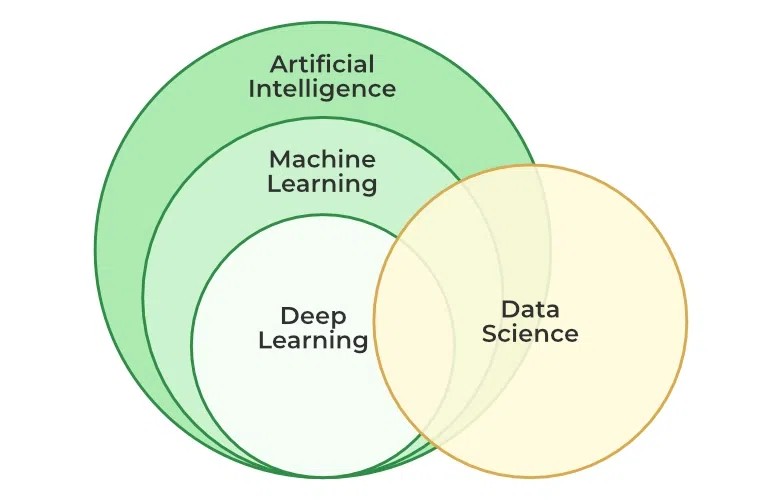The IT industry is constantly evolving, and within it, Data Science stands out as a particularly dynamic and in-demand field. If you’re exploring career paths in technology, you’ve likely encountered both Machine Learning (ML) and Deep Learning (DL). These two terms are central to Data Science, but understanding their distinctions is crucial. This article will break down the core differences between Machine Learning and Deep Learning, helping you to navigate these exciting areas and determine which might be the best fit for your professional journey.
What is Machine Learning?
Machine Learning is a branch of Artificial Intelligence (AI) that empowers computer systems to learn from data without explicit programming. At its heart, Machine Learning involves developing algorithms and statistical models that can analyze datasets, identify patterns, and then utilize these learned patterns to make predictions or informed decisions about new, unseen data. The key is training these algorithms on substantial datasets, enabling them to autonomously discover relationships and insights.
Types of Machine Learning
Machine Learning is categorized based on the nature of the data used for training and the learning approach. Common types include:
- Supervised Learning: Algorithms are trained on labeled data, where the desired output is known. This allows the model to learn a mapping between inputs and outputs, enabling predictions on new labeled data. Examples include classification and regression tasks.
- Unsupervised Learning: In contrast, unsupervised learning uses unlabeled data. The algorithms explore the data to find inherent structures and patterns, such as clusters or anomalies. Clustering and dimensionality reduction are typical unsupervised learning tasks.
- Reinforcement Learning: This type focuses on training agents to make sequences of decisions in an environment to maximize a cumulative reward. The agent learns through trial and error, receiving feedback in the form of rewards or penalties. Robotics and game playing are common applications.
What is Deep Learning?
Deep Learning, on the other hand, represents a more specialized subset within Machine Learning. It distinguishes itself by employing neural networks with multiple layers to process and analyze data. These “deep” neural networks are inspired by the intricate structure and function of the human brain, allowing them to discern highly complex patterns and relationships that might be missed by traditional Machine Learning algorithms.
Deep Learning has achieved remarkable success across diverse and challenging domains, including:
- Computer Vision: Enabling machines to “see” and interpret images and videos, powering applications like image recognition and object detection.
- Natural Language Processing (NLP): Facilitating interactions between computers and human language, driving advancements in machine translation, sentiment analysis, and chatbots.
- Speech Recognition: Converting spoken language into text, essential for voice assistants and dictation software.
Deep learning models are trained using vast quantities of data and sophisticated algorithms. Their strength lies in their ability to learn and improve over time, becoming increasingly accurate as they are exposed to more data. This characteristic makes them exceptionally well-suited for tackling intricate, real-world problems where patterns are subtle and data volumes are immense. Deep learning models can adapt and generalize to new situations with remarkable proficiency.
 Data Science Hierarchy: Illustrating the relationship between Artificial Intelligence, Machine Learning, and Deep Learning, highlighting Deep Learning as a subset of Machine Learning and both within the broader field of AI.
Data Science Hierarchy: Illustrating the relationship between Artificial Intelligence, Machine Learning, and Deep Learning, highlighting Deep Learning as a subset of Machine Learning and both within the broader field of AI.
Types of Deep Learning
Deep Learning encompasses a range of neural network architectures, each designed for specific types of data and tasks:
- Convolutional Neural Networks (CNNs): Excel at processing image and video data due to their ability to detect spatial hierarchies of features.
- Recurrent Neural Networks (RNNs): Designed to handle sequential data, such as text and time series, by maintaining a memory of past inputs.
- Artificial Neural Networks (ANNs): The foundational structure, forming the basis for more complex deep learning architectures.
- Generative Adversarial Networks (GANs): Used for generative tasks like image synthesis, consisting of two networks competing against each other.
- Transformers: Revolutionized NLP tasks with their attention mechanisms, enabling parallel processing of sequential data and capturing long-range dependencies.
Future of Machine Learning and Deep Learning
Both Machine Learning and Deep Learning are poised to revolutionize numerous industries. Their ability to extract meaningful insights from data and automate complex decision-making processes makes them invaluable tools for the future. Industries predicted to be significantly impacted include:
- Healthcare: For improved diagnostics, personalized medicine, and drug discovery.
- Finance: For fraud detection, algorithmic trading, and risk assessment.
- Retail: For personalized recommendations, inventory optimization, and customer behavior analysis.
- Transportation: For autonomous vehicles, traffic management, and logistics optimization.
Difference Between Machine Learning and Deep Learning
While both Machine Learning and Deep Learning fall under the umbrella of Artificial Intelligence and aim to extract knowledge and make predictions from data, their approaches, complexities, and capabilities differ significantly. Understanding these distinctions is key to choosing the right technique for a given problem.
The following table summarizes the key differences between Machine Learning and Deep Learning:
| Feature | Machine Learning | Deep Learning |
|---|---|---|
| Relationship | Broader field, Deep Learning is a subfield | Subset of Machine Learning |
| Data Representation | Typically uses structured data | Primarily uses neural networks (ANNs) for data representation |
| Evolution | Evolution of AI | Evolution of Machine Learning; “deeper” form of ML |
| Data Size | Effective with thousands of data points | Thrives on Big Data; millions of data points |
| Output Types | Often numerical values, classifications | Numerical values, free-form text, sound, images |
| Algorithms | Variety of algorithms, analysts select for specific data variables | Neural networks automatically learn features through processing layers |
| Algorithm Detection | Data analysts choose algorithms to examine data variables | Algorithms largely self-defined on data analysis during production |
| Use Cases | Broad applications, staying competitive, learning new things | Solving complex, intricate machine learning problems |
| Computational Needs | Can often be trained on CPUs | Dedicated GPUs (Graphics Processing Units) are typically required for efficient training |
| Human Intervention | More human intervention needed to achieve results, feature engineering is manual | Less intervention once running, feature extraction is automated |
| Setup & Run Time | Faster setup and run times initially, but effectiveness may plateau | Longer setup time, but can produce results rapidly once running, improving with more data |
| Training Time | Shorter training times due to smaller models and datasets | Longer training times due to large datasets and complex networks |
| Feature Engineering | Requires manual feature engineering by humans | Feature engineering is largely automated by neural networks |
| Hardware Requirements | Simpler applications, can run on standard computers | Demands more powerful hardware and computational resources |
| Result Interpretability | Results are typically easier to interpret and explain | Results can be more challenging to interpret and explain (black box problem) |
| Problem Complexity | Suitable for straightforward to moderately challenging problems | Well-suited for tackling highly complex and intricate problems |
| Current Applications | Banks, doctor’s offices, mailboxes, simpler automation | Self-driving cars, advanced robotics, complex pattern recognition |
| Pattern Recognition | Identifies patterns and relationships in data | Analyzes more intricate patterns and relationships using complex neural networks |
| Algorithm Complexity | Algorithms range from linear models to decision trees and random forests | Algorithms based on multi-layered artificial neural networks |
| Data Requirements (Quantity) | Requires less data, but data quality is critical | Requires large amounts of data for effective training |
| Typical Applications | Regression, classification, clustering, simpler tasks | Image and speech recognition, NLP, autonomous systems, complex tasks |
| Accuracy for Complex Tasks | Can be less accurate for very complex tasks | Generally more accurate for complex tasks due to deep networks |
Conclusion
In conclusion, understanding the difference between Machine Learning and Deep Learning is essential for anyone aiming to build a career in Data Science or leverage these technologies effectively. While both are powerful tools for data analysis and prediction, they operate on different principles and are suited to different types of problems. The distinction between Deep Learning and Machine Learning often comes down to the depth and complexity of the algorithms employed and the scale of data they can handle. Machine Learning vs Deep Learning is best viewed as a spectrum, with Deep Learning extending the foundations of Machine Learning to tackle increasingly sophisticated tasks and achieve higher levels of accuracy in complex domains.
Difference Between Machine Learning and Deep Learning – FAQ’s
What is the basic difference between Machine Learning and Deep Learning?
Machine Learning (ML) is a broad field within Artificial Intelligence focused on enabling computers to learn from data and make predictions using algorithms and statistical models. Deep Learning (DL) is a specialized subfield of ML that utilizes deep neural networks with multiple layers to analyze complex patterns in large datasets, inspired by the structure of the human brain.
How do Machine Learning and Deep Learning algorithms differ in terms of complexity?
Machine Learning algorithms typically range from simpler models like linear regression and decision trees to more complex models like support vector machines. These algorithms generally have fewer layers and a less intricate architecture. Deep Learning algorithms, conversely, employ complex neural networks with many layers of interconnected nodes, allowing them to model highly non-linear relationships and extract hierarchical features from data.
What types of data are best suited for Machine Learning Vs Deep Learning?
Machine Learning techniques are often effective with structured data and smaller datasets. They are suitable when feature extraction can be performed manually or when data is well-organized. Deep Learning excels with unstructured data such as images, audio, and text, and benefits significantly from large datasets where it can automatically learn relevant features and patterns without explicit manual feature engineering.
